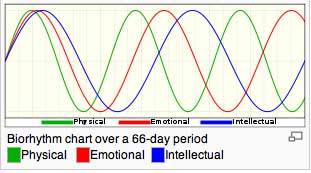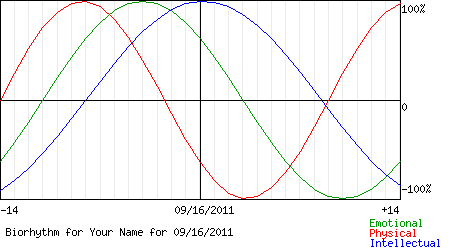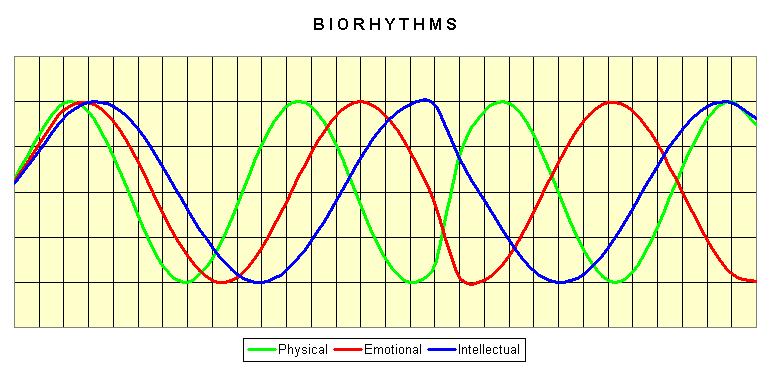Biorhythm
Biorhythm is a blank hypothesis, which states that the physical and intellectual capacity, as well as the state of mind of the people are subject to certain rhythms that are common to all people, starting with the day of birth. These rhythms are presented using a so-called Biorhythmogrammes.
Biorhythmustheorie
The biorhythm is based on three " rhythms " with different period:
- Physical rhythm (23 days)
- Emotional rhythm (28 days)
- Mental rhythm (33 days)
At birth, these rhythms to sinusoidal positive start with their first period after a half- period length cross the zero line and then go into a negative phase. At the end of the period is again an envelope in the positive range. All transitions, i.e. from positive to negative and vice versa are intended to be critical days, or potentially "bad" days. If, now in all three phases in a transition on the same day, which can, according to the doctrine biorhythmical have crises episodes - during the meeting positive days shall particularly have good days result.
The basis for this simple statement was laid in the early 20th century by the Viennese psychologist Hermann Swoboda and the Berlin physician Wilhelm Fliess. Flow believed to have discovered regularities according to the medical records of his patients and put them first in his teaching period. They tried so behind the "good" and "bad" moments of a life a law to discover ..
High gained popularity of biorhythms in the 1980s with the advent of the first programmable calculators and home computers. The age in days and the resulting Biorhythmuszustand could be calculated quickly through easy to write and use programs. Today Worksheets are provided with formulas for common spreadsheet programs, as a Java applet or as a standalone small programs; mostly as freeware (free), partly as shareware (paid service). The calculation formulas used in this case always go there on the same theory ( Swoboda / flow ) back.
Demarcation
Delimit From this Biorhythmustheorie are the biological rhythms in chronobiology, which examines the temporal organization of living things by scientific methods. Chronobiological rhythms, which are described in biology and medicine, are subject to natural fluctuations, which is why these days strictly periodic cycles of biorhythms for scientific biology and medicine are not plausible and also contradict findings of the biological sciences. Therefore, in the Chronobiology the rigid rhythms of Biorhythmustheorie be rejected.
The postulated from the biorhythmics long-term rhythms are not measurable and scientific evidence; so lifted in one study, the hit rate in predicting the probability of an accident from using the methods of biorhythm in a study in which 3000 traffic accidents were analyzed, no statistical random values .
To avoid misunderstandings, biological rhythms is used within the chronobiology of the term, what has not, however, enforced in everyday language.








